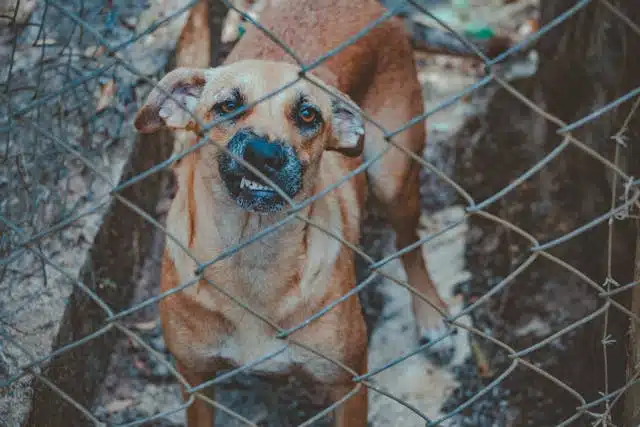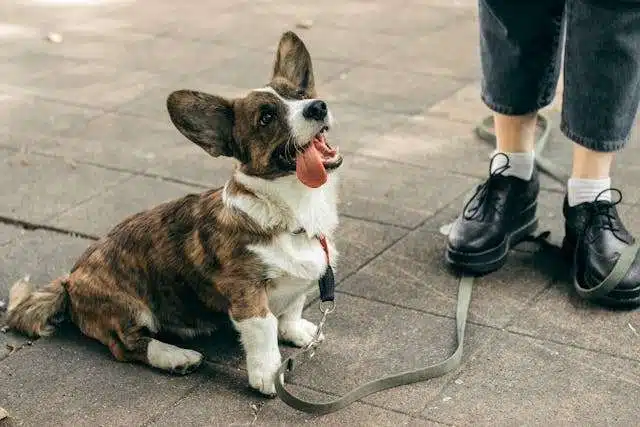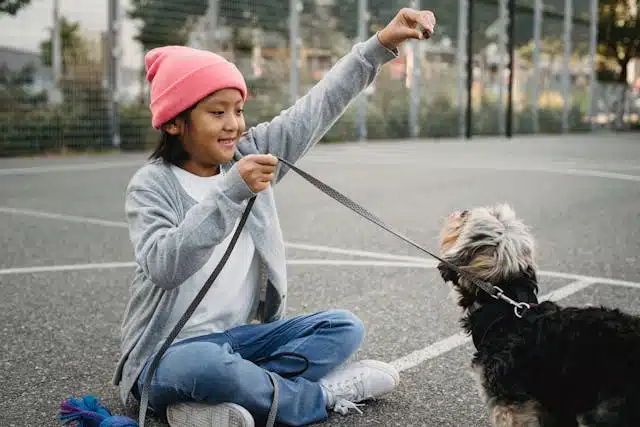Barrier Aggression in Dogs is a behavior that occurs when you see your dog barking, growling, or even biting behind a fence. This can be very confusing and scary for a lot of people. The best way to handle it is to grasp its origins and put in place a solid plan to deal with it. So in this piece, we’ll chat about Why dogs display barrier aggression, ways to tackle it, as well as steps you can take to stop it. We’ll also go over some common triggers of barrier aggression and how to spot them.
Table of Contents
ToggleWhat is Barrier Aggression In Dogs?
First up, we’re going to talk about what barrier aggression is. Well, it’s any sort of aggressive behavior such as intensive barking, biting, lunging, or snapping in the presence of other people on the other side of something that creates a barrier. It can also be behind a door, a baby gate, or even the fence in your backyard. Dogs with this issue might get feisty towards people, animals, or both. Want to know why? Let me fill in!
What is The Reason Behind Barrier Aggression In Dogs?

So, on to why. Why does barrier aggression occur? One of the reasons is frustration. Perhaps your dog wants to get to another dog on the other side of a fence or another structure to play with them. That can actually cause some aggressive tendencies. If you’ve ever seen any videos where you have all these dogs on one side barking at all the other dogs on the other side, and then you remove the gate, and suddenly everyone is cool or walks away or plays, that’s one of the reasons—because they’re frustrated and that’s one of the ways they communicate that frustration.
Territorialism can play a part in that as well. Another thing that really contributes to some barrier aggression issues is resource guarding. What’s in the crate? Is it a blanket, a bed, or a food bowl? Are they confined to a specific area with some of their things only, and they’re very used to that?
These are some reasons you can see barrier aggression begin to arise if you’ve never seen this type of behavior in your dog before, but now all of a sudden they’re getting barky, lungy, snippy, and bitey at other animals or people in the confinement of a crate, behind a baby gate, or a door or a fence.
What's Causing It?
There could be some contributing factors. Stressors are a big indicator. Moving, new changes, a new baby in the house, perhaps you brought a new dog home, or maybe you’ve changed something in your normal routine. Pain is also an underlying indication. It’s common for dogs to hide their pain well, so if they seem guarded or protective of particular areas, they might be in pain. If this behavior is new, speak to your veterinarian and rule out any possible causes of this behavior.
Here's How To Solve Crate Aggression and Guarding
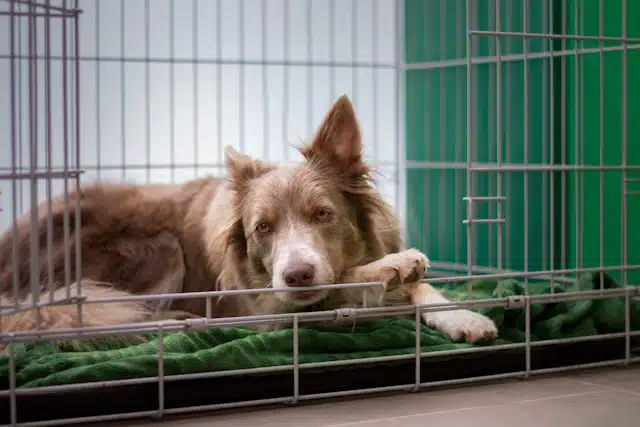
We now need to talk about how to help your dog if they are suffering from barrier aggression. First things first, we’re going to remove items out of the area of confinement. Whether it’s behind a baby gate, in a closet, in a small space, or even a crate, items can increase the likelihood that they’ll feel the need to guard that space. We’re going to start with nothing in the crate to begin with, and then as the dog gets more comfortable, we might add different things back.
Unlike other dogs, my dog doesn’t have a barrier, food, or toy aggression issue, so I’m fine or comfortable taking things out of his crate. If there were a dog next to me or near me, I would not attempt that because I could get hurt in the process of him going after the other dog because of the items.
After removing all the items I’m going to start with the next step, which is super simple, and that’s just a positive association with people approaching the crate. My dog’s issue is with the dogs, but I’m starting a step back. I’m starting with people. He already likes me, so I want to make this a routine practice that’s absolutely normal. When he sees me coming, it’s nothing but good things. I’m going to use a low-value item like his kibble. He’ll work for his kibble, but it’s nothing super valuable.
So I’m just using his regular chicken and rice dog food, and all I’m doing is approaching the crate and dropping in a treat. Dogs with human-related barrier aggression might not receive this treat directly; you might just drop it in. In my dog’s case, he can take it either way, but all I’m doing is letting him know that when I walk up to that crate, yummy things come.
The reason I’m doing this is because eventually, I’m going to walk up to the crate or past the crate with a dog, which he doesn’t like. I want him to know that when I’m coming, it means good things are happening, even if I’m coming with something else he might be concerned about.
This is an exercise I will do with every single family member in the house so that the same ideas, expectations, and positive associations are across the board with all members of the household. The same goes for all dogs in the household. You start with one dog at a time, and then we’ll do this rotation with all dogs in the household as well.
Now that I’ve given my dog some practice with a simple approach, we bring in another dog, and the real work begins. I will start at a distance where my dog is non-reactive. This is best done with two people: one person interacts with the new dog, and the other rewards the confined dog simultaneously.
So, For this exercise, I break out the high-value treats. I’m using Stewart’s freeze-dried liver, which my dog goes completely gaga for. I begin with simple drive-bys with my body in between the two dogs, and as I walk by, I drop a piece of liver to my dog.
During this step, don’t stop moving. Your time with the two dogs close by should be very brief. You want to keep the pressure that the other animal creates to a minimum. This is a step that I will practice over and over until I see some signs from my dog that he’s becoming much more comfortable with the situation.
Barrier-aggressive behavior can seem pretty explosive when it happens, but there are some precursors to look for. Some of the things I look for that indicate a dog is about to display aggressive tendencies behind a barrier are a tense, stiff body, a stiffened tail, seeing the whites around the eyes much more than usual, and even just a slight hold of the breath. These are all indicators of stress.
As I work through these exercises, the goal is to reduce these signs by helping the dog behind the barrier become much more comfortable. Once I see more of a loose body, a loose tail, less of that white eye or whale eye, and even an inquisitive posture or an offered sit instead of a defensive posture, that’s when I’ll move to step two, where now the two dogs are right next to each other, and I’m on the opposite side.
Then I’ll repeat this step over and over, looking for the same signs of the dog relaxing, and then I’ll start the approach with a pause with the other dog.
I walk the other dog up to the crate, stop and pause for a moment, offer a food reward, and then offer that pressure relief once again.
What To Do If Your Dog Aggresses At Gates / Fences
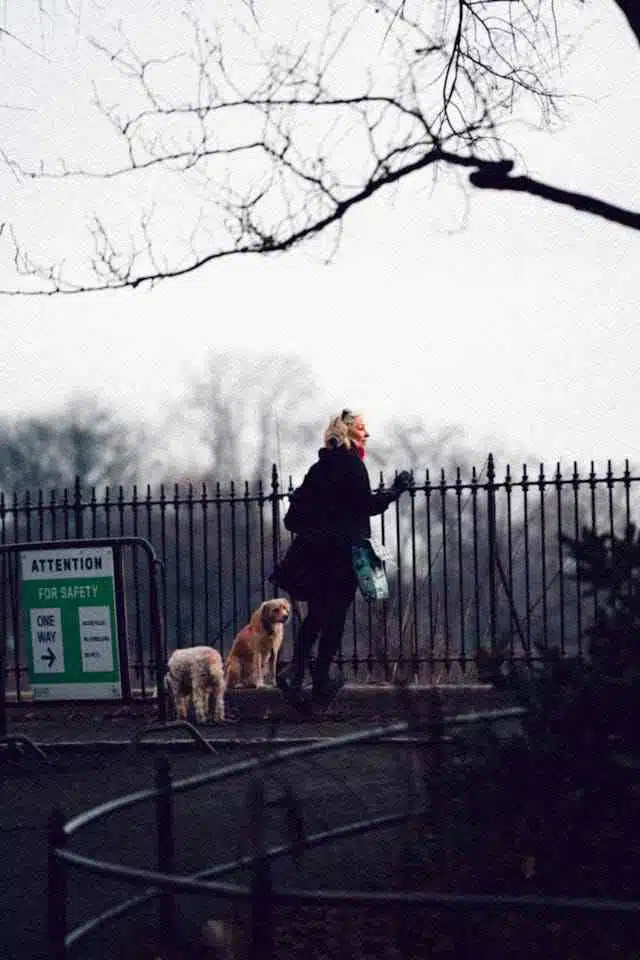
In this example, I have my dog, behind a baby gate. This gate acts as a barrier. Many dogs have issues with even just this much between them and whatever else they want to get to or whatever else is behind the gate they’re protecting. I’m doing the exact same thing I did with the crate, where I’m just offering some positive reinforcement every time I approach the gate. I walk away, come back, approach, and drop a little treat on the floor. Again, starting off with just me, with a low value.
If he were afraid of other people or reactive to other people on the other side of the barrier, I would start with high value, but with me, he’s not, so we’re going to use the high value for what sets him off the most, which is other dogs.
Now, in that last approach, we did, my dog’s tail was wagging and his body was much looser. He might not be 100% comfortable with this process because it takes quite a while, give yourself at least a couple of weeks.
Barrier Aggression Can Be Helped By Impulse Control
There’s one more piece I want to share with you, which is how to do this behind a door where you can’t easily deliver treats, just like I told you behind the gate and with the crate. But before I do that, I want to mention how important impulse control exercises are outside of these very specific barrier aggression exercises as well. When dogs react to other animals and people, they’re usually pretty impulsive-it’s just straight-up behavior.
By working on impulse control outside of these activities, it helps them be in more of a thinking state of mind more frequently and can kind of throw that reactivity process to a bit more of a halt by putting them into a thinking state rather than just an action pattern. These exercises will help your dog develop deferred gratification, making them calmer and more controlled in various situations.
How To Stop Your Dog From Aggressing At The Door
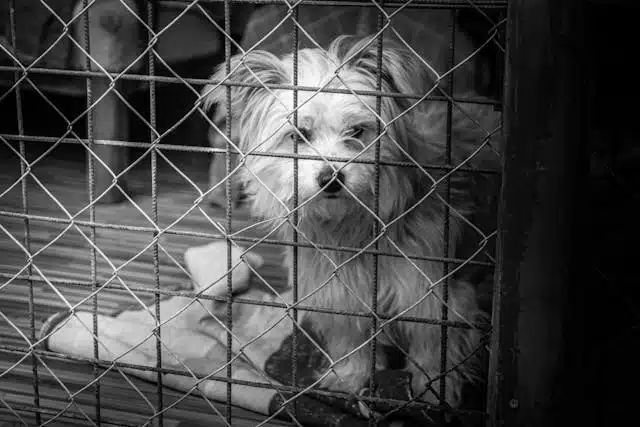
You might be thinking, what do I do when I have a barrier where I can’t easily deliver treats? Well, here’s a great example. My dog is actually very aggressive behind our French doors, especially toward the other dogs in the house. So again, I’m going to start off the same way as before, with my low-value treat, and all I’m going to do is just open the door for a split second, pop a treat, close the door, leave, re-approach, open the door, deliver a treat.
The reason I’m doing this repetitively is so that he knows every time I approach the door, something yummy happens. That way, when I approach the dog, he’s less likely to be concerned, and he’ll know I have something good coming.
So the next step is incorporating the dog and bringing the dog in small, short spurts. When you’re behind a door barrier, it’s much more helpful if you have a second person working with you so they can reward the dog on the same side of the door while you simultaneously walk around with the other dog in brief moments.
Right now, it’s just me. I’ll teach you what I’m doing, but the first couple of times you do this, have some help—have someone else on the other side of the door who can provide reward systems, food, or even squeaky toys or whatever they enjoy, while the other person on the outside is completely separate from them, just occupying that space so good things are happening while they’re outside occupying that space.
Another thing I’m going to do is when I bring the reward to my dog, I’m going to toss it away from the door a little bit, just to give him some pressure relief since the presence of the other dog makes him anxious. So I also give him a little bit of relief at the same time.
After each training session, it is important to put the barrier back in place as soon as possible. As the barrier is the primary trigger of your dog’s aggression, it is crucial you practice routinely with it until your dog is comfortable around it. After I remove the barrier and open the door, he is no longer aggressive towards other dogs.
Barrier aggression can be a very frustrating and confusing experience for owners. While dogs might be perfectly fine without a fence or a crate, or behind another barrier, it can be a completely different and scary, unsafe story with that barrier in place or confinement in place. With persistence and work over a couple of weeks with positive reinforcement, every time what causes them concern is around, you can really start to reduce these issues and safely have dogs interacting in the same room, even with a barrier in place.
So Persistence is key—going slow and steady, moving at their pace, and making sure that only positive and good things happen when other people or animals are near the barrier that’s causing that concern.
Don't Do These Things!
Before you head off, I want to talk about what you shouldn’t do, which is just as crucial as what you should. Don’t yell, punish, or hit your dog in any way because that will make the situation much worse. Now imagine when you yell and someone else yells, it’s like you’re both yelling at once, with the energy through the roof. In dogs, the combination of arousal and high energy, which occurs in a similar way in humans, leads to accidents and situations that are extremely dangerous.
So be sure not to yell at your dog and cause further stress and frustration. The same goes for hitting—make sure you’re not hitting the top of the crate. All you’re doing is adding fuel to the fire and causing more reasons for them to be concerned and exhibit aggressive behaviors.

